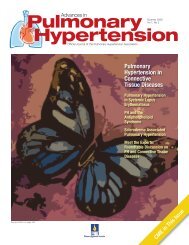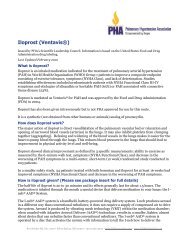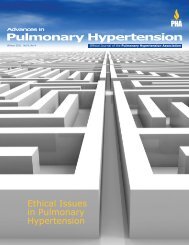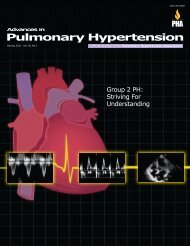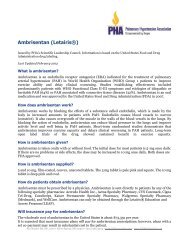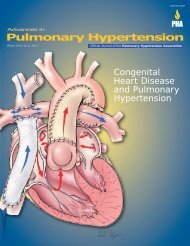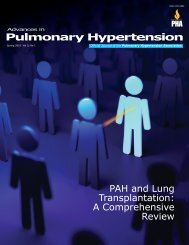Vol 7, No 3 - PHA Online University
Vol 7, No 3 - PHA Online University
Vol 7, No 3 - PHA Online University
You also want an ePaper? Increase the reach of your titles
YUMPU automatically turns print PDFs into web optimized ePapers that Google loves.
Advances in Pulmonary Hypertension CME Section<br />
Program Overview<br />
Pulmonary arterial hypertension (PAH), an incurable<br />
disease, is characterized by medial hypertrophy, intimal<br />
fibrosis, and in situ thrombi in small muscular pulmonary<br />
arteries. PAH was considered a rapidly fatal illness with<br />
a median survival of 2.8 years in the 1980s when no<br />
evidence-based therapies were available. Since then<br />
the treatment of this disease has made tremendous<br />
advances, and the last 10 years have seen the discovery<br />
of new medications that have positively influenced the<br />
prognosis and survival of patients with PAH.<br />
This self-study activity is based on 5 articles that review<br />
the latest information on new treatments, combinations<br />
of therapies, and data from phase 1 and 2 clinical trials.<br />
This activity is jointly sponsored by the <strong>University</strong> of<br />
Michigan Medical School and the Pulmonary Hypertension<br />
Association and supported by an unrestricted<br />
education grant from Actelion Pharmaceuticals US, Inc,<br />
Encysive Pharmaceuticals, Inc, Gilead Sciences, Inc,<br />
Pfizer, Inc, and United Therapeutics Corporation.<br />
Target Audience<br />
This self-study activity is appropriate for cardiologists,<br />
pulmonologists, rheumatologists, and other physicians<br />
who treat patients with pulmonary hypertension.<br />
Learning Objectives<br />
Upon completion of this activity participants will be<br />
able to:<br />
1. Review the various animal models used in PH<br />
research to date<br />
2. Compare and contrast the different pathological<br />
findings in animal models of PH<br />
3. Define the metabolic syndrome<br />
4. Define “diabetic cardiomyopathy”<br />
5. Review the effects of metabolic syndrome on<br />
energy production in cardiac myocytes<br />
6. Identify novel hemodynamic measurements that<br />
can be made during right heart catheterization<br />
Self-Assessment Examination<br />
See pages 351 and 352 for self-assessment questions,<br />
answer key, and evaluation form.<br />
Faculty<br />
Karen Fagan, MD<br />
Chief, Division of Pulmonary and<br />
Critical Care Medicine<br />
<strong>University</strong> of South Alabama<br />
Mobile, Alabama<br />
Contributing Authors<br />
Heiko Bugger, MD, PhD<br />
Division of Endocrinology, Metabolism and<br />
Diabetes<br />
Program in Human Molecular Biology and<br />
Genetics<br />
<strong>University</strong> of Utah School of Medicine<br />
E. Dale Abel, MD, PhD<br />
Division of Endocrinology, Metabolism and<br />
Diabetes<br />
Program in Human Molecular Biology and<br />
Genetics<br />
<strong>University</strong> of Utah School of Medicine<br />
Paul M. Hassoun, MD<br />
Professor of Medicine and Director of the<br />
Pulmonary Hypertension Program<br />
Division of Pulmonary and Critical Care Medicine<br />
Johns Hopkins <strong>University</strong>, School of Medicine<br />
Kurt Stenmark, MD<br />
Department of Pediatrics<br />
Developmental Lung Biology Laboratory<br />
<strong>University</strong> of Colorado at Denver and<br />
Health Sciences Center<br />
Hunter C. Champion, MD, PhD<br />
Pulmonary Hypertension Program and<br />
Division of Cardiology<br />
Department of Medicine<br />
Johns Hopkins Medical Institutions<br />
Ivan F. McMurtry, PhD<br />
Departments of Pharmacology and<br />
Medicine and Center for Lung Biology<br />
<strong>University</strong> of South Alabama<br />
Agenda<br />
The Metabolic Syndrome and Cardiac Function<br />
Heiko Bugger, MD, PhD and<br />
E. Dale Abel, MD, PhD<br />
National Heart Lung and Blood Institute Hopkins<br />
Specialized Center in Clinical Oriented Research<br />
(SCCOR): Molecular Determinants of Pulmonary<br />
Arterial Hypertension<br />
Paul M. Hassoun, MD<br />
Specialized Center in Clinical Oriented Research<br />
(SCCOR) Update: Mechanisms and Treatment of<br />
Long Vascular Disease in Infants and Children<br />
Kurt Stenmark, MD<br />
Getting More From Right Heart Catheterization:<br />
A Focus on the Right Ventricle<br />
Hunter C. Champion, MD, PhD<br />
Animal Models of Human Severe PAH<br />
Ivan F. McMurtry, PhD<br />
330 Advances in Pulmonary Hypertension



